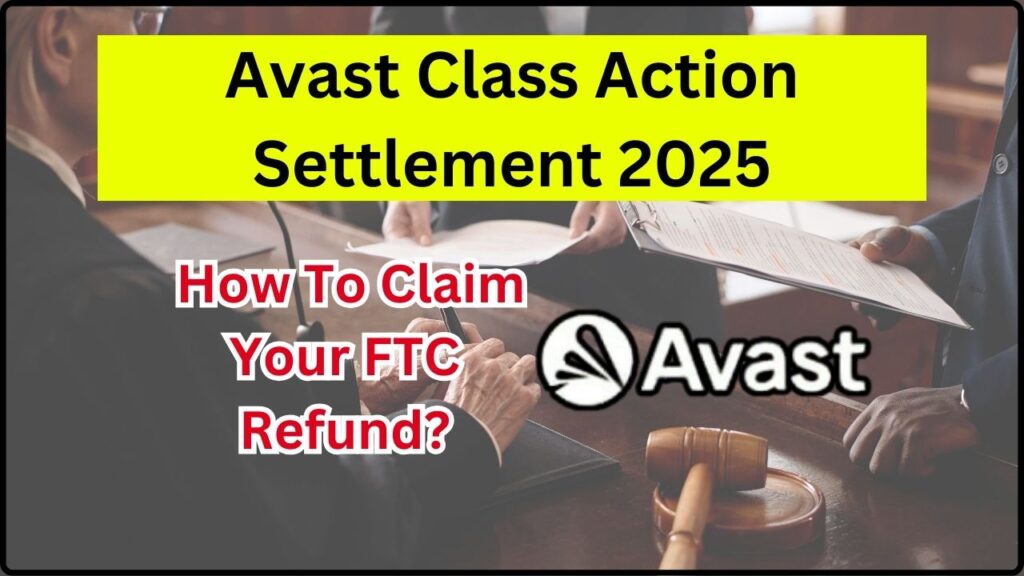
Avast Class Action Settlement 2025: If you purchased Avast antivirus software between August 2014 and January 2020, you’re likely eligible for a refund under the Avast Class Action Settlement 2025, according to the Federal Trade Commission (FTC). This settlement is part of a $16.5 million agreement resolving allegations that Avast collected and sold consumers’ sensitive browsing data—despite advertising itself as a privacy protector. This article breaks down everything you need to know: the background of the case, who qualifies, how to claim your refund, and what you can expect going forward. Whether you’re a casual consumer or a cybersecurity professional, this guide provides all the actionable insights in one place.
Avast Class Action Settlement 2025
The Avast Class Action Settlement 2025 is a powerful reminder that consumer privacy matters, especially when companies promise protection. Whether you’re a long-time user or a cybersecurity advocate, this case offers a valuable lesson in data ethics and consumer trust. If you’re eligible, take advantage of this opportunity to claim your rightful refund. It only takes a few minutes, and it sends a clear message that transparency and consent should be non-negotiable in today’s digital world.
| Aspect | Details |
|---|---|
| Total Settlement | $16.5 million |
| Eligibility Window | Purchases between August 2014 and January 2020 |
| Filing Deadline | June 5, 2025 |
| Expected Refund Distribution | Sometime in 2026 |
| Number of Eligible Consumers | Approximately 3.7 million |
| Settlement Website | avastsettlement.com |
| FTC’s Official Page | FTC Avast Settlement Page |
| Customer Service | 1-866-290-0165 or [email protected] |
What Is the Avast Settlement About?
At the heart of the settlement is the FTC’s accusation that Avast, a popular antivirus software provider, misled customers about their data privacy. While Avast advertised itself as safeguarding users’ digital lives, it was simultaneously collecting vast amounts of web browsing data through its subsidiary, Jumpshot.
This data was then repackaged and sold to over 100 third-party companies for marketing, analytics, and research purposes. Despite the sensitive nature of this information—including location data, religious beliefs, health concerns, political views, and browsing habits—users were largely unaware of the extent of data collection and sale.
The FTC concluded that Avast’s actions violated consumer protection laws by failing to obtain informed consent. As a result, they reached a settlement that includes both monetary compensation for consumers and new restrictions on Avast’s business practices.
Why This Settlement Matters?
This case sets a crucial precedent for the cybersecurity industry and consumer digital rights. Antivirus software holds a unique place of trust, often running continuously on users’ devices with deep access to online activity. When such trust is broken, the consequences extend far beyond a single company.
From a professional perspective, this incident reinforces the importance of transparency, informed consent, and privacy-by-design principles. It also highlights the role of regulators like the FTC in holding companies accountable.
Step-by-Step: How to Claim Avast Class Action Settlement 2025?
Step 1: Check Your Email for a Notification
If you bought Avast antivirus software between August 2014 and January 2020, the FTC may have sent you an email between February 24 and March 7, 2025. This email includes your Claim ID and Confirmation Code, which are necessary to submit your refund request.
Didn’t receive an email? Check your spam or junk folder. Still nothing? You can contact the settlement administrator to request assistance.
Step 2: Visit the Official Settlement Website
Go to www.avastsettlement.com/file-a-claim, the official page to file your refund request. This is the only legitimate portal for claim submissions.
Step 3: Enter Your Claim ID and Confirmation Code
These unique identifiers confirm your eligibility and tie your submission to the consumer data on record. Enter them exactly as they appear in your email.
Step 4: Fill Out the Claim Form
Provide your full name, email address, and preferred payment method. Options may include PayPal, Zelle, or other digital payment services. Review your entries carefully before submitting.
Step 5: Submit Before June 5, 2025
Claims must be submitted no later than June 5, 2025. Submissions after this date may not be processed, so act promptly to secure your refund.
What Happens After You Submit?
Once your claim is submitted, it will be reviewed by the settlement administrator. If everything checks out, your refund will be included in the distribution, currently expected in 2026.
Refund amounts will vary depending on how many people file valid claims. The more claims received, the smaller the individual payouts may be.
Additional Tips and Best Practices
- Don’t fall for scams: The FTC will never ask you to pay to receive a refund. If someone contacts you asking for payment or private banking info, report them to the FTC immediately.
- Keep your records: Save your submission confirmation email or take a screenshot of your submission page.
- Use secure connections: When submitting sensitive information, ensure you’re on a secure internet connection and accessing only the official website.
Air Methods Data Breach Class Action Settlement – Claim $75-$2500, Check Eligibility
Benchcraft Company Class Action Lawsuit in 2025 – Check Eligibility Criteria and Payment Details!
FAQs About Avast Class Action Settlement 2025
Who is eligible for a refund?
Anyone who purchased Avast antivirus software for personal use between August 2014 and January 2020 and received a claim email from the FTC.
How much money will I get?
The refund amount depends on the number of valid claims filed. As of now, no specific amount has been guaranteed.
What if I didn’t receive a Claim ID?
You can still contact the administrator at 1-866-290-0165 or email [email protected] for help.
Is there any cost to claim the refund?
No. Filing a claim is completely free. If anyone asks you to pay or share your bank info, it’s likely a scam.
Can I track my claim status?
The settlement website will provide updates and information on the refund timeline. Monitor the site for news on processing and payment schedules.







